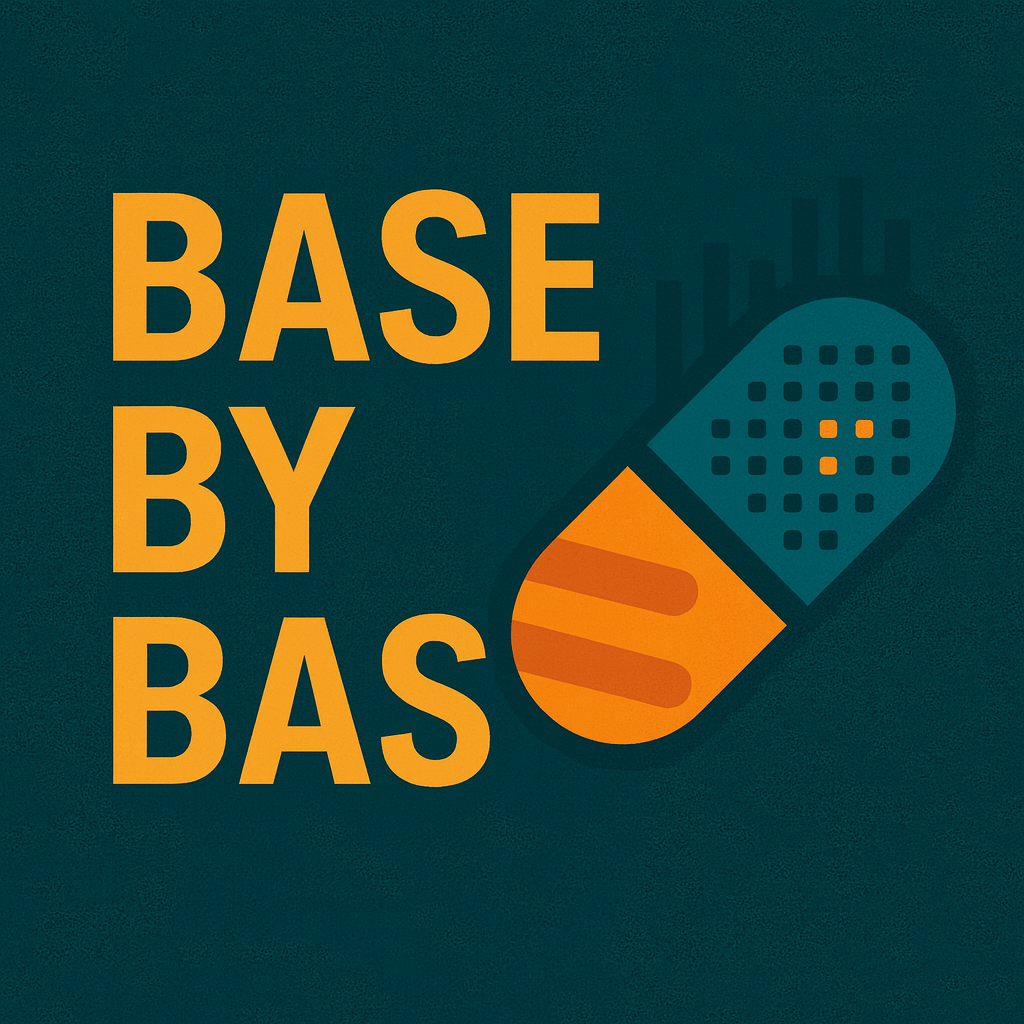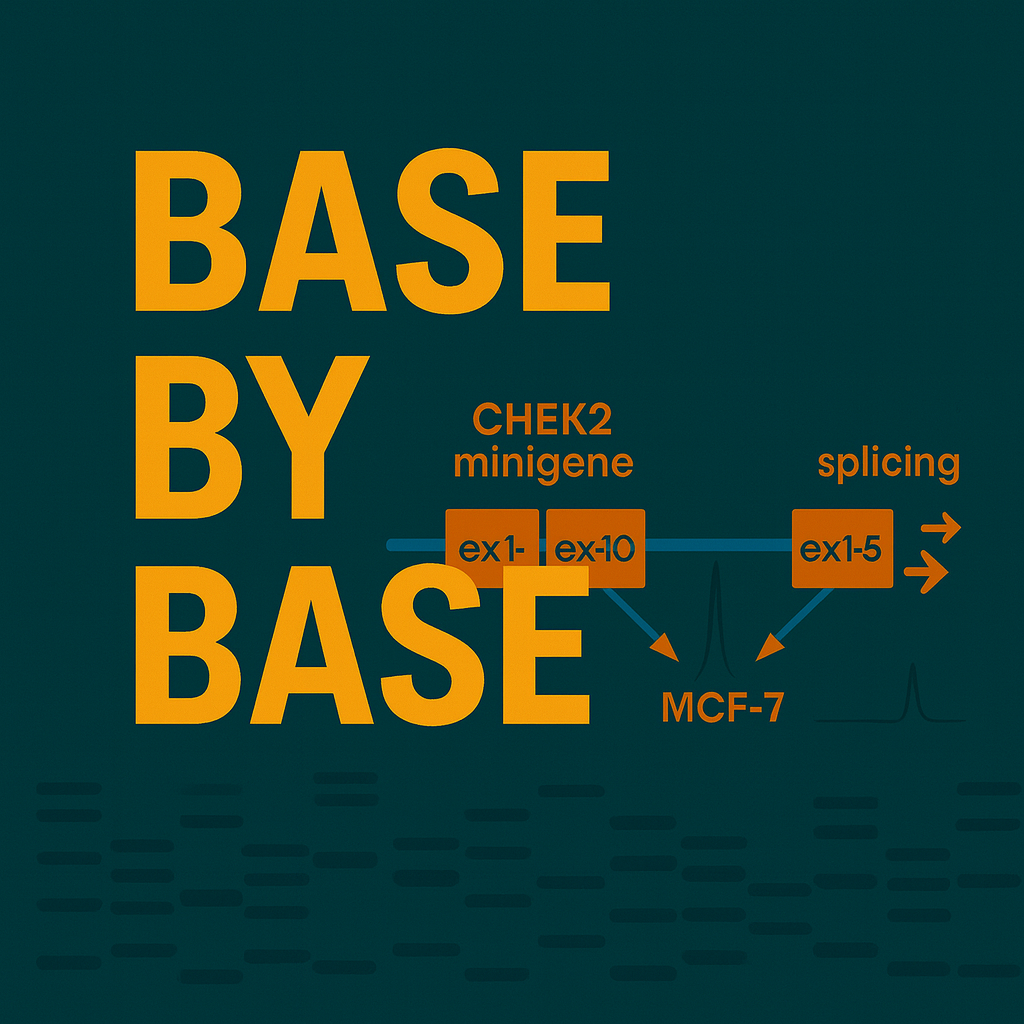Episode Transcript
[00:00:14] Speaker A: Welcome to Base by Base, the papercast that brings genomics to you wherever you are.
Today we're diving into something that, well, it really impacts all of us, why our bodies react so differently to the same medications.
You know, that feeling, a drug works wonders for a friend, but for you, maybe it does nothing. Or worse, you get side effects. It's a really common thing.
[00:00:35] Speaker B: It is. And that's exactly where pharmacogenetics, or PGX is often called, comes in. It's the whole field studying how your specific genes, your unique genetic blueprint, influence how you respond to drugs. Okay, and today we're going to unpack. This really monumental study reveals just how common these genetic differences actually are and. And importantly, what that really means for how we think about personalized medicine.
[00:01:00] Speaker A: Right. So have you ever found yourself just wondering, you know, why did that prescription not quite work for me? Or maybe it caused some weird reaction. Even though it's perfectly safe for most people, it's not just bad luck, is it? We're talking about some common medications maybe only working well for, what, 25% of people. Sometimes, though, it can go up to 80%.
[00:01:17] Speaker B: Exactly. And it's not random chance. Like you said, our genes are playing a really significant role in this variability.
And this variation, this challenge, it really sets the stage for that big idea of precision medicine. Tailoring treatments specifically to you based on your biology. Makes sense, but you should wait until you hear the actual scale of these genetic variations they found across this huge population. And crucially, the, let's say, nuanced implications this has for actually doing personalized drug therapy, especially in a group that hasn't been studied nearly enough in the past.
[00:01:51] Speaker A: Okay, you've got my attention. And addressing that gap, that lack of data is exactly what the Taiwan Precision Medicine Initiative aim to do. So today, we really want to celebrate their groundbreaking work. We're talking about a large consortium here, researchers from Academia sinica and what, 33 partner hospitals across Taiwan.
[00:02:08] Speaker B: That's right, a major collaboration.
[00:02:10] Speaker A: Their dedication has seriously advanced our understanding of how genes influence drug response, particularly within Asian populations, which has been a huge blind spot. So just to make sure everyone's on the same page, let's quickly define pharmacogenetics. Pgx. Again, it's the study of how your individual genetic makeup affects how you mature, metabolize drugs. Right. How effective they are and your risk of side effects.
[00:02:31] Speaker B: Precisely. It's all about connecting your DNA to your drug response. The ultimate goal is, of course, to optimize treatment. Right drug, right dose, right person. And the core problem this huge study tackles is. Well, it's vital. We've known for a while that genes cause variability in how people respond to drugs. And PG gas holds this incredible promise for improving treatments.
But the evidence base from really large scale population based studies has been pretty scarce, especially outside of European populations. Most of the research historically is focused there.
[00:03:03] Speaker A: Which is why existing efforts like the guidelines from the US FDA or the Clinical Pharmacogenetics Implementation Consortium, cpic, while important, might have limitations.
[00:03:13] Speaker B: Exactly. They're crucial first steps for getting PGX into the clinic. Absolutely. But challenges remain. Sometimes different agencies have conflicting recommendations. Right. And the really critical issue is the lack of data from diverse populations. Genetic variants and how common they are can differ a lot between ancestries.
[00:03:31] Speaker A: Okay.
[00:03:32] Speaker B: This creates a major gap. If we want to implement PGX fairly and effectively around the world, we need precision medicine to benefit everyone.
[00:03:38] Speaker A: Which brings us right to the methodology of this Taiwan Precision Medicine Initiative study. The scale is just huge. It's a retrospective analysis. Right. Using genetic data and long term clinical data from the TPMI cohort. And that cohort included, you mentioned it earlier. Almost half a million people, 486,956 Han Chinese individuals.
[00:03:59] Speaker B: That's correct. It is by far the largest Asian cohort ever studied for pharmacogenetics.
The insights are potentially unparalleled because of that scale and focus. And the genetic data collection was quite thorough. They genotyped participants using custom SMP arrays, TPMV1 and TPMV2. What's really key here is that these arrays were specifically designed with thousands of pharmacogenetic markers optimized for the Han Chinese population.
[00:04:24] Speaker A: Ah, so tailored for relevance.
[00:04:26] Speaker B: Exactly. For better accuracy in that population. And then to get an even broader genetic view, they used imputation, basically filling in genetic gaps using whole genome sequencing data from the Taiwan Biobank.
[00:04:38] Speaker A: Okay, so robust genetic data, but it wasn't just about the genes. Right. The clinical side was just as important.
[00:04:44] Speaker B: Absolutely essential. They used electronic medical records, EMRs, to get that longitudinal data, information on drug prescriptions over time, and crucially, any reported adverse drug events. This allowed them to actually link the genetic profiles to real world patient outcomes. They then focused very rigorously on four specific gene drug pairs. They chose these because there was enough data for strong statistics and because they represent common clinically relevant scenarios.
[00:05:10] Speaker A: What were those pairs?
[00:05:10] Speaker B: Okay, so first azathioprine or AZA. That's an immunosuppressant and it's linked to the nut 15 and TPMT genes. They look specifically for myelosompression, which is a dangerous drop in blood cell production. Second, clopidogrel, a common antiplatelet drug, and the Cyt2C19 gene. The focus there was on major adverse cardiovascular events, things like heart attack or stroke. Third, statins, those widely used cholesterol drugs like atorvastatin, simvastatin. Looking at interactions with ABCG2, PYP2C9, and SLCO1B1. Genesis, they investigated statin associated myopathy, or SAMS, which means muscle pain or weakness.
[00:05:49] Speaker A: Okay, that's a common one people hear about.
[00:05:51] Speaker B: It is. And finally, non steroidal anti inflammatory drugs, NSAIDs, and the CYP2C9 gene. Here they assess risks like gastrointestinal bleeding or kidney problems. So each pair represents a situation where we already suspect genetics plays a role.
[00:06:08] Speaker A: Got it. Okay, let's get to the findings then. What did this massive study actually uncover? You mentioned the prevalence was high. The numbers here are pretty staggering. They found that almost everyone, 99.9% of participants, carried at least one genetic variant known to potentially affect drug response.
[00:06:24] Speaker B: It's incredible, isn't it? Virtually universal.
[00:06:26] Speaker A: And on average, each person carried about 4.3 of these clinically actionable PGX risk variants. That's a lot.
[00:06:33] Speaker B: It really is. It shows these variants aren't rare. Quirks. They're a common part of our genetic landscape. And this wasn't just theoretical. Looking at the drug prescriptions, almost half the participants, 48.7%, had actually been prescribed at least one drug that has a known PGX recommendation tied to it.
[00:06:48] Speaker A: Wow. Okay.
[00:06:49] Speaker B: And maybe even more striking, nearly 18% were prescribed drugs considered high risk for their specific genetic profile. Meaning, according to guidelines, those drugs might need dose adjustments or perhaps shouldn't be used at all for that person.
[00:07:04] Speaker A: Okay, so the variants are common, people are getting prescribed relevant drugs.
But here's where you said it gets interesting. Maybe a bit counterintuitive. The study confirmed the statistical length. These risk variants are associated with more adverse events or less effectiveness. But the actual added risk for any given individual was found to be relatively small.
[00:07:24] Speaker B: That's the critical nuance. Exactly. Most patients with the so called risk variants actually don't experience the adverse event.
[00:07:32] Speaker A: So it's not destiny. The gene doesn't automatically mean you'll have a problem.
[00:07:34] Speaker B: Precisely. Take clopidogrel. People with certain CYP2C19 gene variants, the loss of function ones, did have a higher risk of Mace, about 1 1/2 times higher. Statistically significant okay, but the vast majority, almost 86% of people with those risk variants took clopidogrel just fine. No me reported or look at azathioprine. Certain NUDT15 gene profiles were definitely linked to side effects like low white blood cells. And very strongly linked, like 10 times the risk to mass of HA loss.
[00:08:04] Speaker A: Wow, 10 times.
[00:08:05] Speaker B: Yeah, a big odds ratio. But even in that group, only about 21% of the carriers actually experienced severe side effects from AZA. Most tolerated it.
[00:08:14] Speaker A: So still a minority experiencing the issue even with the strong genetic predisposition.
[00:08:19] Speaker B: Correct. Same story with statins. Certain gene variants in AVCG2 or SLC01B1 were linked to a higher risk of muscle problems. But again, over 98% of people with those high risk genetic profiles did not report muscle issues.
[00:08:31] Speaker A: 98% were fine.
[00:08:33] Speaker B: Right. And for NSAIDs, while a CYP2C9 variant showed some link to GI bleeding, the analysis suggested that other things, like having high blood pressure or diabetes or taking certain other medications at the same time, were actually much bigger contributors to those adverse events than the CYP2C9 gene status alone.
[00:08:50] Speaker A: Okay, that's really important context.
[00:08:52] Speaker B: It is. These examples really drive home that PGX risk is usually just one piece of the puzzle, rarely the whole story.
So reflecting on all this, what does it really mean for precision medicine? The study concerns the statistical links. Yes, PGX variants matter, but and this is the key takeaway, I think the relative risk increase is often low or maybe moderate. It's not absolute.
[00:09:16] Speaker A: Right.
[00:09:16] Speaker B: Which really underscores that PGX testing isn't like a crystal ball. It doesn't give a definitive yes, no answer for every person. So it raises this really important practical question.
If these variants are so incredibly common, but the individual risk of something bad happening is often low, how do we best use this information in the clinic?
[00:09:35] Speaker A: Yeah, how do we use it effectively without maybe scaring people unnecessarily or stopping them from taking a drug that could actually help them.
[00:09:43] Speaker B: Exactly.
[00:09:43] Speaker A: It sounds like the message is that PGX is a critical tool. Definitely valuable, but it absolutely has to be used alongside everything else a doctor considers patient history, other health conditions, other medications they're taking, it complements that picture. It doesn't replace it.
[00:09:58] Speaker B: That's the perfect way to put it. It complements it, doesn't replace it helps identify people who might be at higher risk, gives us a heads up. But it needs holistic integration. It's not a standalone magic bullet.
And there are practical considerations. Too many of these adverse events, like the statin muscle pain are often reversible if you stop the drug.
They aren't always life threatening.
[00:10:20] Speaker A: Okay.
[00:10:21] Speaker B: And sometimes trying to avoid a drug because of a PGX risk might mean you end up using an alternative that's less effective or maybe even carries different, potentially worse risks. Think about Clopatogrel. Again, for some elderly patients, Even with the CYP2C19 risk variant, the alternative drugs might carry such a high bleeding risk that E clopidogrel is still the safer overall choice for them.
[00:10:45] Speaker A: So it's always that risk benefit calculation specific to the individual, Always person by.
[00:10:49] Speaker B: Person, situation by person situation.
[00:10:50] Speaker A: Now, like any study, especially one this complex, there were limitations, weren't there? It's important we touch on those. You mentioned the clinical data came from just one hospital per participant.
[00:11:00] Speaker B: That's right. In Taiwan, people often visit multiple hospitals. So if a patient got a drug or had a side effect treated at a different hospital, it wouldn't necessarily be in the record used for this study. That could lead to some underestimation.
[00:11:11] Speaker A: Okay, and what else?
[00:11:13] Speaker B: Well, they couldn't track over the counter NSAID use, which is common, so exposure might be underestimated there too. On the genetic side, they use SMP arrays. These are powerful, but they don't capture every possible genetic variation. Things like very rare variants or variants in complex regions like repeats might be missed.
[00:11:32] Speaker A: Like the CYP2D6 gene you mentioned earlier.
[00:11:34] Speaker B: Exactly. CYP2D6 is notoriously tricky to genotype accurately with arrays because it's structurally complex and it's involved in metabolizing something like 20% of common drugs. That's a known challenge. Also, just the nature of EMR data, electronic medical records means there's variability. Different doctors, different hospitals might record notes slightly differently across those 33 sites.
[00:11:57] Speaker A: Introduces some noise, potentially a little bit, yes.
[00:12:00] Speaker B: And one other important concept, phenoconversion wasn't explicitly measured. That's where things like other drugs someone is taking or their health status can actually change how their body responds to a drug. Sort of mimicking a different genetic profile.
[00:12:15] Speaker A: Right? The environment interacting with the genes.
[00:12:17] Speaker B: Precisely. That interaction wasn't directly assessed here.
So given all this, the findings and the limitations, where does research go next? Well, clearly we need to dig deeper into other factors, both genetic and non genetic, that contribute to adverse events, especially for people who have side effects without carrying the known PGX risk variants. What's going on there?
[00:12:38] Speaker A: Yeah, good question.
[00:12:39] Speaker B: And conversely, what about the protective factors? Why do most people with risk variants tolerate the drugs just fine? Understanding that could be huge maybe lead to new ways to manage risk finding the resilience factors. Exactly. We also need to develop and really refine risk management strategies, especially where current guidelines from bodies like CPIC or the FDA are still evolving or maybe aren't fully comprehensive yet.
And fundamentally, this all just reinforces the critical need for more large scale PGX studies in diverse, underrepresented populations globally. That's the only way to build guidelines that work for everyone.
So if we boil it all down, what's the main take home message from this deep dive? I'd say it's this huge study in a Han Chinese population confirms that pharmacogenetic variants are incredibly common. They are statistically linked to drug side effects. However, the actual individual risk of experiencing those side effects is often quite low. Which means PGX information is definitely a powerful tool, but it's one piece of a much larger clinical puzzle. It needs to be combined with all other patient information to truly personalize medicine effectively.
[00:13:41] Speaker A: That's a great summary. It really highlights the complexity, but also the potential. So thinking forward then, what does this really mean for how we approach drug prescription and personalized medicine on a global scale, especially as we keep gathering more and more data from diverse populations all around the world?
This episode was based on an Open Access article under the CC BY 4.0 license. You can find a direct link to the paper and the license in our episode description if you enjoyed this analysis. The best way to support Bass by Bass is to subscribe or follow in your favorite podcast app and leave us a five star rating. It only takes a few seconds, but makes a huge difference in helping others discover the show. Thanks for listening and join us next time as we explore more science base by base.
[00:14:27] Speaker B: Sam.




